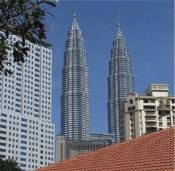If you were to consider the ASEAN region as a single entity it would rank as the eighth largest economy in the world.
 Recently I was interviewed by Sarah Lockett on market growth in the ASEAN region on behalf of the UK-ASEAN Business Council, producing the documentary, “Britain and South East Asia: Prospects for Growth” shown on The Business Channel.
Recently I was interviewed by Sarah Lockett on market growth in the ASEAN region on behalf of the UK-ASEAN Business Council, producing the documentary, “Britain and South East Asia: Prospects for Growth” shown on The Business Channel.
The ten countries of South-East Asia are widely expected to become the biggest story in world growth since the emergence of the BRICS and at IFS we expect this to translate to significant growth in the Aerospace & Defense sectors too – a key strategic focus of IFS.
While only accounting for 3% of global land mass, if you were to consider the ASEAN region as a single entity it would rank as the eighth largest economy in the world, putting it in a position to be seen as a global power and one which is now moving on from manufacturing into developing its own key industries.
Key Growth Areas in ASEAN
If we take the defense industry as an example, the total cost of an aircraft is made up of 20% initial manufacture-driven costs and 80% ongoing through-life in-service costs. Adopting maintenance solutions in the shape of Performance Based Logistics (PBL) will enable defense contractors in the ASEAN region to build the industry, providing global export capabilities and putting the market on a global platform.
Supporting Civil Aviation
It is not just the defense market that is benefiting from this growth – an expected 7% rise in aircraft numbers and maintenance is putting ASEAN ahead in term of civil aviation too. Within 10 years it is predicted that the region will be the largest transport network in the world.
As such, the industry must look at maximizing profit in this industry. The Wall Street Journal reported 99% of the revenue received per flight by airlines is needed simply to break even on the high costs incurred in operation and maintenance.
The largest cost to airlines is fuel, followed by salaries, taking 29% and 20% of revenue respectively. The costs related to maintenance typically make up 11% of revenue, and this is a key area which the ASEAN market should be looking to maximize. It is estimated that a 10% improvement in maintenance can deliver a doubling of profit.
Creating Value Between Britain & The ASEAN Market
There are undoubtedly many challenges when faced with working with such a vast and varied region. Countries such as Singapore and Malaysia have had global trade agreements in place for years making them easier to trade with, while Laos and Cambodia are just evolving as markets in their own right. But trends are pointing towards an EU-like evolution pulling the region together.
- See also: IFS feature in The Malaysian Reserve on how IFS Applications enables customers in ASEAN countries to comply with emerging tax regulations.
At this early stage Britain has an important role to play in providing knowledge through extensive expertise in the A&D industry as does IFS, such as provided by the A&D Center of Excellence. By working with our local offices in the ASEAN region, we can deliver specialist capabilities via regional directors to develop a strong maintenance industry and to enable ASEAN’s growing industries to really take off.